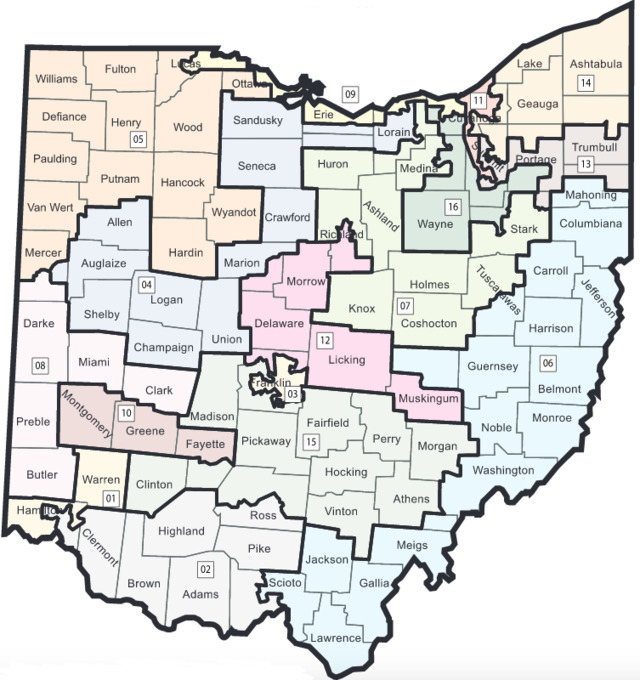The United States Supreme Court today ruled 5-4 that federal courts have no business deciding issues around congressional redistricting, leaving battles about gerrymandering to state lawmakers.
The ruling on cases in North Carolina and Maryland means that Ohio's current congressional districts will stay until 2022, despite a lower court's decision that struck them down as unconstitutional because they provide an advantage to Republicans. The lower federal court ordered Ohio to begin redistricting immediately ahead of the 2020 elections.
The state of Ohio appealed that decision, meaning that the pending redistricting here hinged on the Supreme Court's decision today. Ohio will redistrict again in 2022 under a new process approved by voters when they passed state Issue 1 last year.
In today's decision, a majority of Supreme Court justices — all nominated by Republican presidents — argued that the high court wading into the issue would set a troubling precedent.
"What the appellees and dissent seek is an unprecedented expansion of judicial power," Chief Justice John Roberts wrote in the majority decision. "We have never struck down a partisan gerrymander as unconstitutional — despite various requests over the past 45 years... Consideration of the impact of today’s ruling on democratic principles cannot ignore the effect of the unelected and politically unaccountable branch of the Federal Government assuming such an extraordinary and unprecedented role."
Republicans have applauded the ruling, while Democrats generally have blasted the decision.
The four dissenting judges, led by Justice Elena Kagan, issued a blistering dissent calling the decision "tragically wrong."
"Is that how American democracy is supposed to work? I have yet to meet the person who thinks so," Kagan wrote for the dissenting justices after recounting the extreme gerrymandering in both North Carolina and Maryland. "Election day — next year, and two years later, and two years after that — is what links the people to their representatives, and gives the people their sovereign power. That day is the foundation of democratic governance. And partisan gerrymandering can make it meaningless. At its most extreme — as in North Carolina and Maryland — the practice amounts to 'rigging elections.' "
That was the conclusion a panel of three federal judges reached May 3, when they unanimously ruled that Ohio's congressional map is unconstitutional.
The ruling found that mapmakers manipulated congressional districts to benefit the Republican Party, a violation of voters' constitutional right to choose their elected representatives. Under their ruling, Ohio wouldn't have been permitted to hold another election using the map. The judges ordered state lawmakers to submit a new one by June 14.
The Ohio A. Philip Randolph Institute, the Ohio League of Women Voters, the American Civil Liberties Union and other groups brought the lawsuit challenging Ohio's 2012 congressional redistricting.
Ohio's current congressional map was drawn by a Republican-controlled panel in a Columbus hotel room in December 2011. From 2012 to 2016, Republicans in Ohio won 56 percent of the state's votes for U.S. House candidates. But they netted 75 percent of Ohio's seats in the House. In 2018, that pattern repeated, with Democrats getting only four of the state's 16 seats.
That's because many of the state's congressional districts are drawn so that races in them aren't competitive, groups challenging it say. Instead, large numbers of reliably conservative voters are concentrated in districts like Ohio's 1st Congressional District, which encompasses the west side of Hamilton County and deep-red Warren County. U.S. Rep. Steve Chabot has held that district since the 1990s, save a brief exception in 2009 when Democrat Steve Driehaus defeated him for a single term just before the districts were redivided.
The federal judges tore into that district and others like it, stating that "the plausible explanation for District 1's configuration was the predominant desire to crack Democratic votes in Cincinnati, a cohesive center that would likely have elected a Democratic representative."
Overall, the map shows intent to draw districts for political gains, the judges said.
“In this case, the bottom line is that the dominant party in state government manipulated district lines in an attempt to control electoral outcomes and thus direct the political ideology of the state’s congressional delegation,” the judges' ruling reads.
According to the lower court's ruling, many of the districts are drawn — sometimes with wildly convoluted shapes — so as to divide up major population centers like Cincinnati, which have more liberal and minority voters. Heavily-urban Cuyahoga County, for example, is split four ways, each small section mixed with much more conservative suburban and rural areas.
That division devalues the votes of urban communities, including predominantly minority ones, critics say.
Ohio Legislative Black Caucus President State Rep. Stephanie Howse said the caucus is "extremely disappointed" in the Supreme Court's ruling today.
"Despite the past achievements in seeking equality at the ballot box, we continue to see communities targeted and muted for political gain," she wrote in a statement. "The right to vote should never be marginalized as it is sacred to our nation’s democracy and promise. Ohioans made their clamor for change to our electoral maps known when they voted to pass Issue 1 in May 2018. The Supreme Court has failed the people with this ruling in setting a precedent that allows our democracy to be corrupted and hinders the people’s right to have fair elections."
The Supreme Court's decision doesn't mean partisan gerrymandering in places like Ohio isn't an issue, the court said, but it is one that state lawmakers and voters should handle.
"Our conclusion does not condone excessive partisan gerrymandering," the decision says. "Nor does our conclusion condemn complaints about districting to echo into a void. The States, for example, are actively addressing the issue on a number of fronts."
Currently, the party controlling Ohio's General Assembly and governor's office has almost complete control over how congressional districts are drawn every 10 years. The current map was drawn up in 2011 mostly in a hotel room in Columbus rented for $9,600 in taxpayer money by staffers for Republican state legislators. Two of those two staffers, Ray DiRossi and Heather Mann, were each paid $105,000 as contractors for their work drawing the maps.
The group working on the redistricting project called the hotel room "the bunker." Correspondence between those working on the map and others within the GOP shows that, among other changes, mapmakers redrew boundaries to include now-Ohio GOP Chair Jane Timken's headquarters in Canton in U.S. Rep. Jim Renacci's district. At the time, Timken was the vice chair of the Stark County GOP and a major Renacci donor.
The request for that change and others came from the office of then U.S. House Speaker John Boehner, who, according to the correspondence, had final say over the map.
But in May last year, Ohio voters approved Issue 1, which seeks to reform the redistricting process. Under the reforms, legislatures will still draw the maps, but at least half of Democrats and half of Republicans in the legislature will have to approve the maps. If they can't agree, a seven-member, bipartisan lawmaker commission will take over the redistricting, with at least two votes from members of each party needed to approve a map. If that also fails, the legislature can then draw a map without any restrictions — but it will be good for only four years, not 10.






